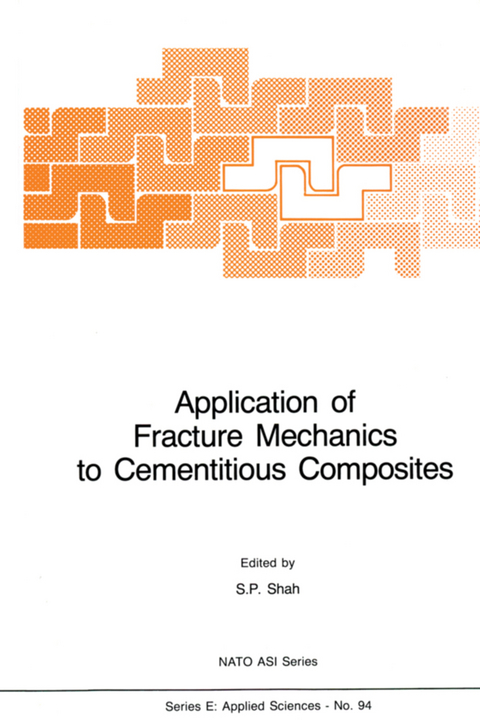
Application of Fracture Mechanics to Cementitious Composites
Kluwer Academic Publishers (Verlag)
978-90-247-3176-3 (ISBN)
- Titel z.Zt. nicht lieferbar
- Versandkostenfrei
- Auch auf Rechnung
- Artikel merken
Portland cement concrete is a relatively brittle material. As a result, mechanical behavior of concrete, conventionally reinforced concrete, prestressed concrete, and fiber reinforced concrete is critically influenced by crack propagation. It is, thus, not surprising that attempts are being made to apply the concepts of fracture mechanics to quantify the resistance to cracking in cementious composites. The field of fracture mechanics originated in the 1920's with A. A. Griffith's work on fracture of brittle materials such as glass. Its most significant applications, however, have been for controlling brittle fracture and fatigue failure of metallic structures such as pressure vessels, airplanes, ships and pipe lines. Considerable development has occurred in the last twenty years in modifying Griffith's ideas or in proposing new concepts to account for the ductility typical of metals. As a result of these efforts, standard testing techniques have been available to obtain fracture parameters for metals, and design based on these parameters are included in relevant specifications. Many attempts have been made, in the last two decades or so, to apply the fracture mechanics concepts to cement, mortar, con crete and reinforced concrete. So far, these attempts have not led to a unique set of material parameters which can quantify the resistance of these cementitious composites to fracture. No standard testing methods and a generally accepted theoretical analysis are established for concrete as they are for metals.
Section I: Advances in Nonlinear Fracture Mechanics.- Nonlinear Response of Concrete: Interaction of Size, Loading Step and Material Property.- Fracture Process Zone of Concrete.- Nonlinear Analysis for Mixed Mode Fracture.- Section II: Fracture Processes in Cement Composites: Experimental Observations.- On the Cracking in Concrete and Fiber Reinforced Cements.- Fracture and Damage Mechanics of Concrete.- Fracture Processes in Fiber Reinforced Cement Sheets.- Some Aspects of Experimental Techniques.- Section III: Numerical Modeling of Fracture.- Continuum Model for Progressive Cracking and Identification of Nonlinear Fracture Parameters.- Nonlinear Fracture Models for Discrete Crack Propagation.- Interpretation of the Griffith Instability as a Bifurcation of the Global Equilibrium.- Section IV: Experimental Methods of Determining Fracture Parameters.- Nonlinear Fracture Parameters for Cement Based Composites: Theory and Experiments.- Size Effects in the Experimental Determination of Fracture Mechanics Parameters.- Fracture Measurements of Cementitious Composites.- Fracture Resistance Parameters for Cementitious Materials and Their Experimental Determinations.- Section V: Damage and Continuum Modeling.- Mechanics of Solids with a Progressively Deteriorating Structure.- A Microstructural Approach to Fracture of Concrete.- Application of Continuous Damage Mechanics to Strain and Fracture Behavior of Concrete.- On a Continuum Modeling of Damage.- Section VI: Strain-Rate and Dynamic Effects on Crack Propagation.- Dynamic Effects in Concrete Materials.- Tensile Fracture of Concrete at High Rates of Loading.- Section VII: Stress-Corrosion, Time and Temperature Effects on Fracture.- Influence of Time on Crack Formation and Failure of Concrete.- Rate of Loading Effects on the Fracture of Cementitious Materials.- Section VIII: Implications for Concrete Structures.- The Role for Fracture Mechanics in Conventional Reinforced Concrete Design.- Improvements in Concrete Design Achieved Through the Application of Fracture Mechanics.- Design Codes and Fracture Mechanics.- List of Participants.- Author Index.
| Erscheint lt. Verlag | 31.8.1985 |
|---|---|
| Reihe/Serie | NATO Science Series E ; 94 |
| Zusatzinfo | 728 p. |
| Verlagsort | Dordrecht |
| Sprache | englisch |
| Themenwelt | Naturwissenschaften ► Physik / Astronomie ► Mechanik |
| Technik ► Maschinenbau | |
| ISBN-10 | 90-247-3176-3 / 9024731763 |
| ISBN-13 | 978-90-247-3176-3 / 9789024731763 |
| Zustand | Neuware |
| Haben Sie eine Frage zum Produkt? |
aus dem Bereich


